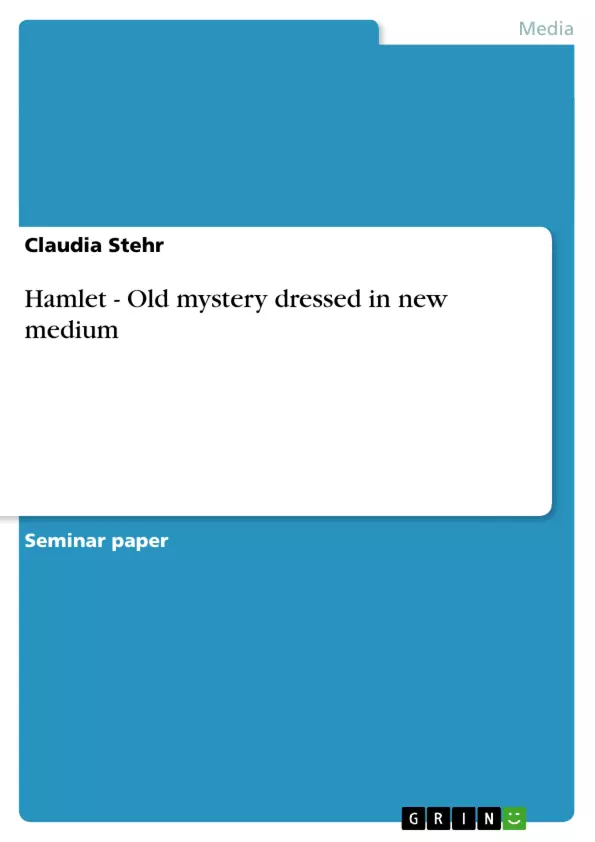A Shakespeare anthology reads:
“Hamlet seems always to have been the most discussed work of literature in the world.” It has fascinated people for all times, and inspired them to critically write about the play itself, Hamlet’s character, or the various contradictions and paradoxes of the plot, e.g. the good or evil nature of the Ghost, Hamlet’s real or pretended madness, or his hesitation to kill Claudius. A sheer volume of material has been published.
It is a play that has put people under a spell, then in the Renaissance, as well as today, 400 years later. Questions have been raised, but the riddle has never really been solved, although different types of critics, theories and analyses have been applied to interpret and understand this world famous dramatic piece of art.
This essay shall not solve the mystery of Hamlet, but examines how Shakespeare's play has been transformed into the medium film and how these adaptations reflect the time in which they were produced. There have been uncountable film reworkings of Hamlet – many of various approaches and emphases. This paper focuses on two versions, Asta Nielsen's silent Hamlet – one of the first Hamlet films ever made, and Hamlet (2000) - the first Hamlet adaptation of the new millennium. Both films are produced in a totally different period of film history with nearly a century in between. Still, they have many similarities, especially concerning the way of how this play has been translated into its given time of production. Therefore, aspects like the circumstances of the films, their place in history, the viewing habits of the audience at that time, film criticism and how the films relate to the issues of the world, are going to be examined. For a precise analysis I have prepared sequence protocols (see appendix) of the films to compare them to each other and to the play. To begin with, a short overview of Hamlet on film is presented to make the reader aware of its long, everlasting history.
Inhaltsverzeichnis (Table of Contents)
- Introduction
- The Tradition of Hamlet on Screen
- Silent versus Sound: Film Analyses
- Hamlet - not Shakespeare's Invention
- Was Hamlet a Woman?
- Hamlet (1920) in its time
- Hamlet - Our Contemporary
- Hamlet (2000) in its time
- Comparing Hamlet (1920) to Hamlet (2000)
- Conclusion
Zielsetzung und Themenschwerpunkte (Objectives and Key Themes)
This essay investigates how Shakespeare's Hamlet has been adapted for film and how these adaptations reflect the time of their creation. The essay focuses on two specific adaptations: Asta Nielsen's silent Hamlet and Hamlet (2000), highlighting their differences and similarities in translating the play to their respective eras.
- The enduring popularity and impact of Hamlet in various media
- The evolution of film adaptations of Hamlet across different historical periods
- The influence of the medium film on interpretations of Shakespeare's play
- The relationship between film adaptations and the social and cultural context of their creation
- Comparing and contrasting the stylistic approaches of different Hamlet films
Zusammenfassung der Kapitel (Chapter Summaries)
- Introduction: The introduction sets the stage by discussing the enduring legacy and influence of Hamlet, highlighting the play's adaptability across various forms. It presents the essay's objectives, focusing on the film adaptations of the play and their reflections of their respective time periods.
- The Tradition of Hamlet on Screen: This chapter provides a brief overview of the history of Hamlet on film, from the early stage reproductions to later adaptations, noting the evolution of filmmaking styles and the play's enduring popularity as a subject for adaptation.
- Silent versus Sound: Film Analyses: This chapter delves into the analysis of two specific Hamlet film adaptations: the silent Hamlet (1920) and the modern Hamlet (2000). It explores the film's historical context, their reception, and their interpretation of the play within their respective eras.
Schlüsselwörter (Keywords)
Key terms and concepts explored in this essay include Shakespeare, Hamlet, film adaptation, silent film, sound film, historical context, cinematic style, interpretation, social commentary, and contemporary relevance.
- Quote paper
- Magistra Artium Claudia Stehr (Author), 2005, Hamlet - Old mystery dressed in new medium, Munich, GRIN Verlag, https://www.grin.com/document/73830



